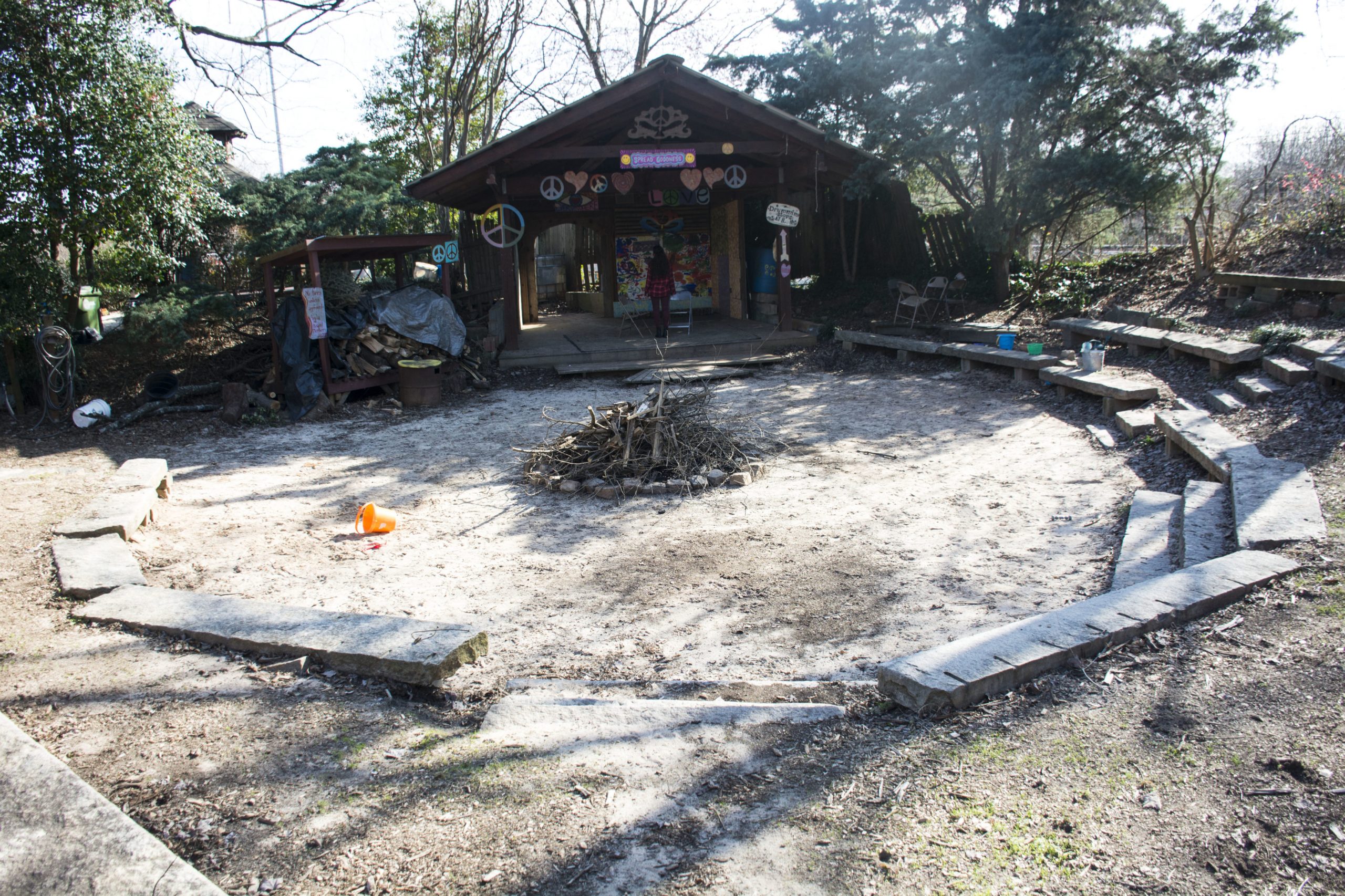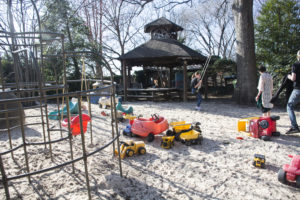
While navigating the Downtown area, spotting greenery means doing so erratically, and more so the closer to campus. For people who live or spend a great deal of time in the city, construction sites have replaced trees as part of the daily view, with new structures erected regularly.
In 1980s Metro Atlanta, Arizona Avenue residents faced the effects of city-sprawling directly. However, some homeowners banded together and dared to challenge the ill-treatment of the land around them. As a small collective, they founded the Lake Claire Community Land Trust – a nonprofit organization that protects and provides a green space to its Metro Atlanta community.

Photo by Jade Johnson | The Signal
Important Presence
Stephen Wing, the Land Trust’s current secretary and a long-time activist, is quite knowledgeable of the organization’s importance. He is involved with developing the nonprofit’s website content, and designing its brochures and flyers. Wing has served on the board for about a decade, and has lived in Atlanta with his family much longer than that.
It is this informed, intimate relationship that makes him highly qualified to note the reasons Lake Claire’s existence is special. Reasons that include its very location.
“This whole corridor along Dekalb Avenue is the ridge between two watersheds called the Eastern [Continental] Divide. One side goes to the Gulf of Mexico and the other side goes to the Atlantic Ocean,” Wing said. “So it is a significant high point and it’s also significant because, between Decatur and Downtown Atlanta, it’s virtually the last green space in the whole stretch there.”
After purchasing the Atlanta Transit System in the early 70s, the Metropolitan Atlanta Rapid Transit Authority (MARTA) had secured enough power to considerably expand its routes. As noted on MARTA’s website, the East Line, which is now titled Blue Line, was in the works by 1979. During that process, nearby Dekalb Avenue businesses were taken over. The transit system grazed in order to develop structures like an underpass, located just opposite of Lake Claire. The resulting lots of deposited soil were not all beneficial to surrounding inhabitants. It was, however, a call to action.
“The neighbors who lived here when the construction was complete, they saw this empty land and they knew that it could turn into something very good or very bad for their neighborhood. They were able to put together a winning bid when it was put up for auction,” Wing said. “Those original neighbors started working on this, it was originally just kudzu and trash. They put a lot of time and effort into it as a neighborhood group, and they became a community through that effort.”
Making the decision to bid was rather risky, particularly because urbanization was experiencing a growth spurt at the time. Between 1980 and 1990, urban land area in Atlanta broadened by 25 percent, according to New Georgia Encyclopedia. Add six years to that and the percentage jumps to 47.
“This property would have had 90 apartment buildings on it. [That] is what would have happened to it had we not stepped up and managed to have the luck to win. Through a series of strange circumstances, but it all worked out in the end,” Pace, who is a part of the founding group, said.
A Positive Expansion
With resilience as a driving force, Lake Claire has had its own bouts of expansion; the land now spans an impressive 2.3 acres, almost doubling the at-purchase size of 1.4. Similarly, the facility’s attributes and fundraising methods have also transformed over the last 30 plus years.
After a quick walk through the entrance, one of the first attractions visitors notice is the Peace Garden. It is comprised of four miniature garden beds that are designed in the shape of a peace sign, and was used a symbol of solidarity for the Human Peace Sign Vigil in 2007. A wood chip pile follows, available to the community in courteous amounts free of charge. The chips accumulate as donations from tree-removal businesses.
Stroll a bit more to find the Nelms Avenue Farm and Beehives, a space maintained by partnership with another commendable organization.
“It has been used for the last few years by a project called Dads and Uncles, which links up kids who have no father with male mentors, who teach them gardening and provide that important role in their lives,” Wing said.
All throughout the multi-acre grounds are traces of the Land Trust’s core principles. That same sense of collectivism and involvement, which ignited its creation, continues to fuel the Land Trust today.
Take for instance the Japanese Meditation Garden, a new addition that was envisioned by a community member. They assembled a team of volunteers, constructed the area and enhanced the space’s zen theme. Lake Claire’s Gorilla Grill is decorated with eclectic art by various participants. A humble amphitheater is colorfully ornamented with hand-painted murals, and signs, like one that reads “Spread Goodness,” are all extensions of Lake Claire’s mission.
“The mission of the Lake Claire Community Land Trust is to acquire, maintain and protect green space for neighborhood enhancement and education; and to provide a place for neighbors and friends to celebrate nature, community and the arts,” according to their brochure.
An Atlanta Wonder
By the time visitors reach the second gazebo deeper into the area, the location begins to look more and more exotic. The trees are fuller, and the street is no longer in direct sight. It is as though the Land Trust transports guests into a diminutive, safe version of the amazon. Further adding to this feeling is the Peace Pond, added in 2009. It is accompanied by Pond Gardens of roughly 70 beds, each of which are contracted on a yearly basis.
“The fact that there’s a meditation garden, there’s a sunset overlook, [Lake Claire] is intended to be a contemplative place. Except when we are having our wonderful, loud raucous festivals or drum circles,” Pace said.
And then there is Big Lou, the Trust’s resident Emu. The native Australian bird was initially the pet of a neighbor’s son, but he later ended up in the care of Wing’s wife, Dawn.
“He’s been here almost as long as I have about 24 years,” Wing said. “He’s been thoroughly spoiled ever since [and] he gets a lot of visitors [at his] fence. A lot of the neighborhood kids are in love with Lou and they come see him regularly.”
Lou is well-fed, and when the seasons are right, he can nibble on produce from adjacent apple and plum trees by the pond area. Just above the emu’s nesting space is a sauna with quite the history. The relaxation set-up is one of the first projects developed at the Land Trust. Even more impressive is that its showers were added during the 1996 Olympics and campers were given an alternative to overcrowded hotels. While the board is happy to host all visitors, they do request that everyone goes by their rules.
“Everywhere you turn there [are] people doing things cooperatively, other people doing things competitively. And you can really see the difference by the results,” Wing said “This is an example of a different way to do things. That is what we are hoping to communicate to whoever comes here.”
Passing the Torch
Even though the Lake Claire Land Trust has had a remarkable support system, changes over time created new goals. Most of the board members have aged and they would like a wave of fresh, young minds to carry on their work.
“We want people to hear the concept of a land trust, to start thinking about it, to store this concept in their minds,” Pace said. “So when students go out to wherever they’re going to live, they can look around to see if there’s an opportunity to do something like that here. We do want students at Georgia State to know about this.”
The organization’s wishlist provides opportunities for volunteers put their creativity to use for a great cause. Projects on the list include a greenhouse, solar powered water purifier, plant labeling and more. Getting involved is easy with the various fundraisers and events put on by the Land Trust. The board has only one requirement, though.
“Come by walking, biking or marta,” Pace said. Street parking is minimal, but if you do drive, the Trust has permission to direct visitors to the parking lot neighboring shelter. Find more information online at lcclt.org/ or inquire in person. See what the Land Trust is all about at their Dead of Winter Dance Party happening on Feb. 11 at 7 p.m.
On-Site Events
- Drum Circle – first and third Saturday
- Community Workdays – occasional
- Annual Fundraisers – yearly
- Peace & Love festival – yearly
- Memorial Day street sale – yearly
Attractions
- Kids Playground
- Meditation Garden
- Gorilla Grill
- Compost-project
- Amphitheater
Contact:@lcclandtrust
Address:280 Arizona Ave NE, Atlanta, GA 30307
